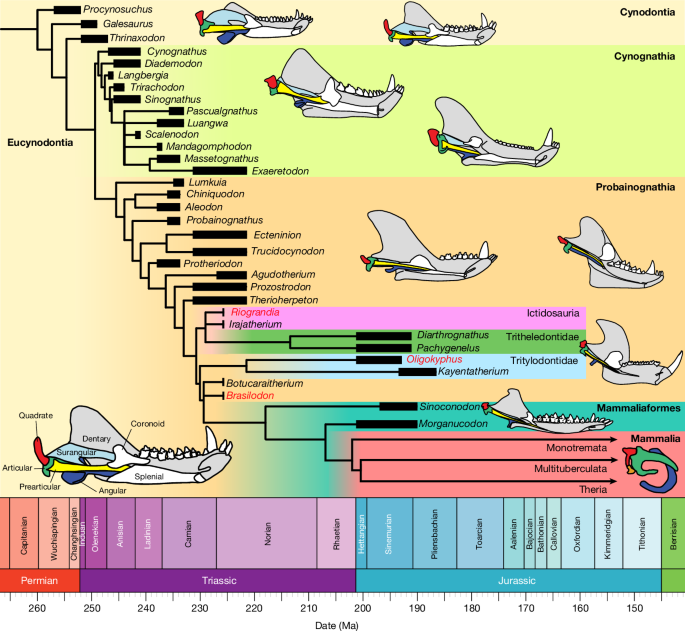wawasan - Evolutionary Computation - # Evolution of Mammalian Jaw Joint in Probainognathian Cynodonts
Brazilian Fossils Reveal Repeated Evolution of Mammalian-like Jaw Joint in Non-mammaliaform Cynodonts
Konsep Inti
The dentary-squamosal jaw joint, traditionally considered a key mammalian feature, evolved independently multiple times in non-mammaliaform probainognathian cynodonts before appearing in mammaliaforms.
Abstrak
The article discusses new fossil discoveries from Brazil that provide insights into the evolution of the mammalian-like jaw joint in non-mammaliaform probainognathian cynodonts. Key points:
The acquisition of the dentary-squamosal jaw joint was a crucial step in mammalian evolution, but questions remain about when and how frequently this innovation evolved.
The authors used micro-computed tomography to reconstruct the jaw joint anatomy of three key probainognathian cynodonts: Brasilodon quadrangularis, Riograndia guaibensis, and Oligokyphus major.
They found that the dentary-squamosal contact, traditionally considered a typical mammalian feature, evolved independently in the ictidosaur clade (Riograndia and tritheledontids) approximately 17 million years before it first appeared in mammaliaforms in the Late Triassic.
Contrary to previous descriptions, Brasilodon, the sister taxon to Mammaliaformes, lacks an incipient dentary condyle and squamosal glenoid, and its jaws articulate solely using the plesiomorphic quadrate-articular joint.
The authors postulate that the jaw joint underwent marked evolutionary changes in probainognathian cynodonts, with some clades independently acquiring a "double" craniomandibular contact, while mammaliaforms attained a fully independent dentary-squamosal articulation.
The dentary-squamosal contact is more evolutionarily labile than previously considered, having evolved more than once in the cynodont lineage.
Brazilian fossils reveal homoplasy in the oldest mammalian jaw joint - Nature
Statistik
The dentary-squamosal contact first appeared in the ictidosaur clade approximately 17 million years before it was present in mammaliaforms.
Kutipan
"The dentary–squamosal contact, which is traditionally considered to be a typical mammalian feature, therefore evolved more than once and is more evolutionary labile than previously considered."
Wawasan Utama Disaring Dari
by Jame... pada www.nature.com 09-25-2024
https://www.nature.com/articles/s41586-024-07971-3
Pertanyaan yang Lebih Dalam
What other key morphological innovations or adaptations did non-mammaliaform probainognathian cynodonts develop, and how do they compare to the features seen in early mammals?
Non-mammaliaform probainognathian cynodonts exhibited several key morphological innovations that set them apart from their predecessors and foreshadowed features seen in early mammals. One significant adaptation is the development of differentiated teeth, which allowed for more efficient processing of food. This dental specialization included the emergence of heterodonty, where different types of teeth (incisors, canines, molars) evolved to perform distinct functions, a characteristic that is also prominent in early mammals.
Additionally, probainognathians displayed advancements in the structure of the skull, including a more complex arrangement of cranial bones and a reduction in the size of the post-dentary bones, which is a precursor to the mammalian middle ear. These changes contributed to a more efficient feeding mechanism and enhanced auditory capabilities, traits that are crucial for survival and adaptation in various ecological niches.
In comparison to early mammals, these adaptations highlight a transitional phase where non-mammaliaform cynodonts began to exhibit features that would later be refined in true mammals. For instance, while early mammals possessed a fully developed dentary-squamosal jaw joint, some probainognathians, like Brasilodon, retained a more primitive quadrate-articular joint, indicating a gradual evolutionary shift rather than an abrupt transition.
How might the repeated evolution of the dentary-squamosal jaw joint in non-mammaliaform cynodonts have influenced the subsequent evolution and diversification of mammaliaforms?
The repeated evolution of the dentary-squamosal jaw joint in non-mammaliaform cynodonts likely played a crucial role in shaping the evolutionary trajectory of mammaliaforms. This homoplastic evolution suggests that the dentary-squamosal articulation provided significant adaptive advantages, such as improved jaw mechanics and enhanced feeding efficiency. As these cynodonts independently developed this jaw joint, it may have facilitated their ability to exploit diverse dietary resources, leading to ecological diversification.
The emergence of a fully independent dentary-squamosal joint in mammaliaforms during the Late Triassic represents a pivotal moment in mammalian evolution. This innovation not only allowed for more complex jaw movements but also contributed to the decoupling of the jaw from the skull, which is essential for the development of the mammalian middle ear. Consequently, this anatomical change may have enabled early mammals to occupy new ecological niches, leading to increased diversification and the eventual rise of mammals as a dominant group in various environments.
Furthermore, the presence of multiple evolutionary pathways to similar jaw joint structures underscores the concept of evolutionary plasticity, suggesting that different lineages can adapt to similar challenges through various morphological solutions. This adaptability may have been a key factor in the successful radiation of mammaliaforms following the Triassic period.
What insights can the study of these Brazilian fossil discoveries provide into the broader evolutionary relationships and phylogenetic history of cynodonts and early mammals?
The study of Brazilian fossil discoveries, particularly those of derived non-mammaliaform probainognathian cynodonts, offers valuable insights into the evolutionary relationships and phylogenetic history of cynodonts and early mammals. By utilizing micro-computed-tomography scanning to reconstruct the jaw joint anatomy of key species, researchers can better understand the morphological transitions that occurred during the cynodont-mammaliaform transition.
These fossils reveal that the dentary-squamosal jaw joint, traditionally viewed as a defining characteristic of mammals, evolved independently in different cynodont lineages, indicating a more complex evolutionary narrative than previously understood. This homoplasy suggests that similar environmental pressures may have driven different groups to develop analogous adaptations, highlighting the role of convergent evolution in shaping the mammalian lineage.
Moreover, the findings challenge previous assumptions about the timing and sequence of jaw joint evolution, suggesting that significant evolutionary changes occurred earlier than the appearance of true mammals. This insight helps to refine the phylogenetic tree of cynodonts and mammals, providing a clearer picture of their evolutionary relationships and the timing of key innovations.
Overall, these Brazilian fossils contribute to a more nuanced understanding of the evolutionary dynamics at play during the transition from non-mammaliaform cynodonts to early mammals, emphasizing the importance of fossil evidence in reconstructing the complex history of vertebrate evolution.
0
